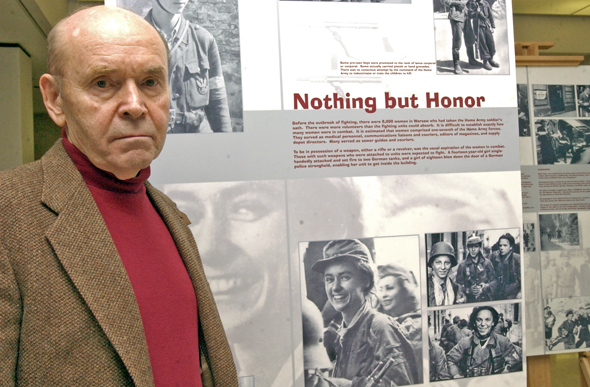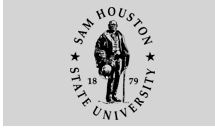 |
Political Science Prof Vic Lukaszewski with a Library exhibit on Poland's 1944 uprising against the Germans.
--Photo by David Gonzales |
Exhibit Honors Poland's Fight for Freedom
In 1939 Germany's surprise invasion of Poland touched off WWII and subjected the people there to six years of occupation under a foreign power. Not to be defeated, members of the legitimate government of Poland coordinated one of the most successful resistance efforts of the war.
During this time, Poland maintained an army, courts, education system and conducted marriages. The entire movement was called the Polish Underground, or the Polish Secret State.
On Aug. 1, 1944, 40,000 Polish men and women took up what weapons they could find, make or steal from the enemy and tried to take back the city. The plan was for the attack to last only a week, after which the Allies would help restore order.
But the battle lasted 63 days. The Germans were prepared for it, and the former Soviet Union's refusal to allow Allied planes into their airspace contributed to the failure of the uprising.
This month, the Newton Gresham Library is displaying an exhibit about the Polish Uprising. It will continue until the end of November and contains books and maps from the archives, and 20 panels with photos and information about the uprising.
The panels feature maps, photos of the men and women involved, and explanations of the tactical importance of some locations throughout Warsaw. The books are all available to be checked out.
The atrocities that were visited on the population are addressed by the exhibit; Poland was decimated by the war, more than 80 per cent of the buildings in Warsaw were razed, and more than 5.6 million Poles were killed. In an article for the Sarmatian Review, Witold Lukaszewski. SHSU political science professor, points out that 90 percent of those who died were civilians.
In addition to the loss of so many lives, countries that were turned over to Communist rule after the war also lost much of their history.
"This exhibit sort of brings to the surface some of the aspects of WWII which are not well known in the West," Lukaszewski said. "Now that these countries have liberated themselves from Communism, they are trying to bring out the untold story."
Besides making every effort to maintain the smaller trappings of freedom, like wedding traditions, the Polish Underground worked to defeat Germany in several highly organized areas.
"They had excellent intelligence services," said Lukaszewski. "They were responsible for duplicating the famous Enigma Machine, which the Germans felt was unbreakable. They gave copies to France and Britain. That essentially gave the Allies the ability to read the Germans' mail."
Lukaszewski, a native of Poland who came to the U.S. in 1950, tried to put the amount of Poland's devastation in perspective.
"The Uprising lasted 63 days and the number of people killed on each of the 63 days was equal or greater than the number of people killed on 9-11. Multiply 9-11 by 63 days and you've got the amount of death that occurred."
After the Germans quelled the insurgence, they destroyed the city and shipped all survivors off to death camps. When Allied soldiers finally liberated Warsaw, there were no buildings to repair, no people to rescue.
Material losses were estimated at 10,455 buildings, 923 historical buildings (94 percent), 25 churches, 14 libraries including the National Library, 81 primary schools, 64 high schools, Warsaw University and Warsaw University of Technology, and most of the historical monuments.
"It [rebuilding Warsaw] was from scratch," said Lukaszewski. "Literally. From scratch. Eighty per cent of Warsaw was in ruins. In the exhibit you'll see the progression. In some cases, the old town square was rebuilt from photographs, old paintings. They tried to rebuild it just they way it was before."
Lukaszewski said he organized the exhibit because he wants people to understand the universal message of war.
"War is a very blunt instrument. It destroys and kills a lot but solves very little. The reasons for war are rarely if ever matched by its outcome. A nation's freedom is a very precious value. And people are willing to die for it."
—END—
Text by Kelly Jakubowski
SHSU Media Contact: Frank Krystyniak
Nov. 17, 2005
Please send comments, corrections, news tips to Today@Sam.edu.
|


